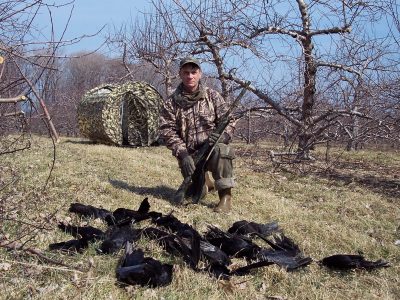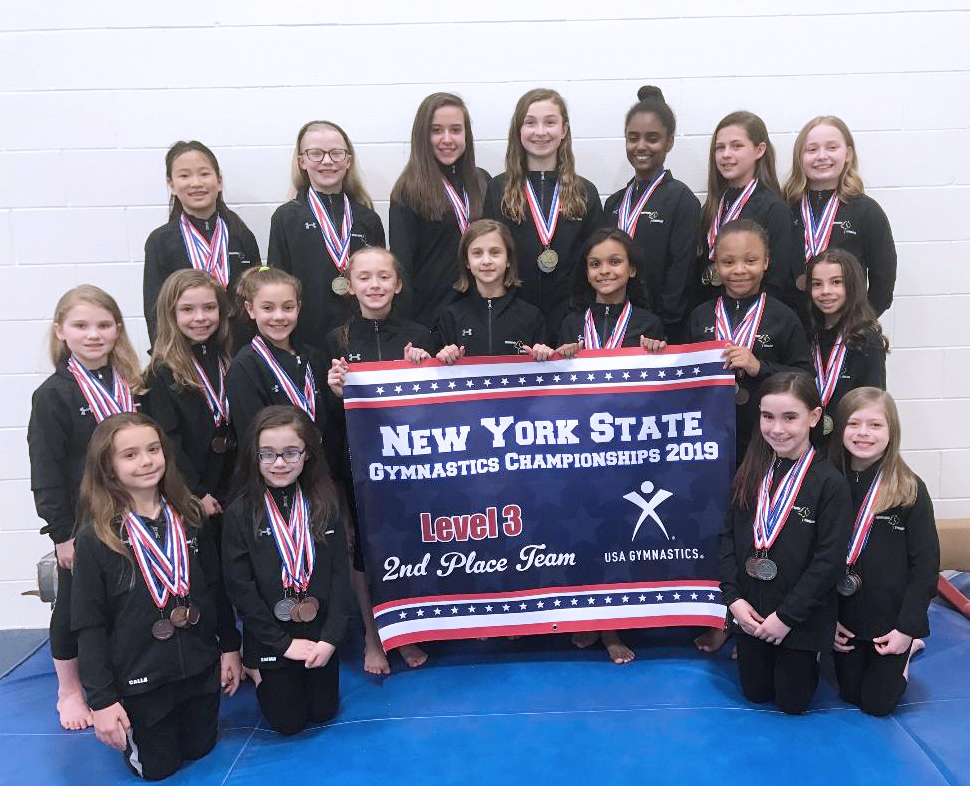Counting crows

The flock of a dozen crows flying the Lake Ontario shoreline suddenly turned inland and made a beeline for our twenty crow decoys strategically placed in the orchard trees. The sound of their cawing could be faintly heard over our digital game caller blaring the sounds of a crow rumble. As the feathered gangsters closed in the lead crow, obviously trying to impress his buddies, kamikazed into our decoy spread, calling loudly as he swooped at our plastic owl decoy. Mike Dwyer jumped from his seat in the haybale blind and rolled the charging bird with one shot from his 12-gauge pump. The trailing gang members flared away, turning back to their migration path along Lake Ontario.
Believe it or not, there is a hunting season for crows in New York State. It runs from September 1st through March 31st on Friday-Monday only. Hunting crows is not as easy as it sounds. They are extremely smart and their eyesight is as keen as any bird of prey.
To get the lowdown on hunting crows in Western New York, I contacted legendary crow hunting expert Mike Dwyer of Irondequoit. Mike has been hunting crows for over a half century. The man hates crows with a passion. Rumor has it that a crow stole his rattle when he was a baby and he has been seeking revenge ever since. The first words Mike spoke as an infant were, “crows must pay!”
Here is what the crow reaper had to say. “The reason I want to shoot every crow I can is because they are terrible nest predators and really do a job on waterfowl and songbird nests, eating their eggs or even young hatchlings. This alone is reason to hunt them in my book. I’m an avid bird watcher and really enjoy feeding songbirds all winter. I figure that for every crow I dispatch I save at least one songbird or waterfowl nest, and probably many more.
“Crows are actually a sub-species of vulture. They are omnivorous feeders and their favorite meal is eggs. A crow will sit for hours in a tree above a nest and wait for the hen bird to leave, then swooping in and eating every egg in the nest.
“There are three main ways to hunt these egg suckers. First is the run-and-gun method where you use an electronic game caller in an area that you know crows are using. Let the caller do the work for you here, decoys are not needed when hunting in this fashion. Full camo is, however, including facemask and gloves. Be ready to shoot shortly after you turn the caller on when using this tactic, crows have great hearing and any birds in the area will be on you in a few minutes. You’d better make the most of it because the first few that arrive will probably be the only birds you will get a shot at. They wise up quickly and the ones you don’t kill will land in distant trees and warn any new birds of the danger. After the first flurry, you will be smarter to move down the road a mile or so and set up again. Decoys are not mandatory in this type of hunting as long as you get tucked into an area where the incoming birds cannot make out what is going on until it’s too late.
“The second method is to locate a crow roost area and hunt the crows’ flyway as they leave their roost in the morning or as they return in the afternoon. Decoys are important with this method and full camo as usual. Crows’ worst enemy is an owl and they will brawl with every one they find; an owl decoy can be deadly when hunting roosting crows. Most roosting crows fly out in the morning on the same route every day, so you can pattern and hunt them along the route. Be sure not to set up closer than a half mile from the actual roost and you can continue to hunt the same crows for weeks.
“The third method, and my favorite, is hunting migrating crows. Believe it or not, crows do migrate. Even the crows that roost in the City of Rochester all winter migrate to Canada in mid-February. Crows and raptors will not fly over large expanses of water, so when they hit the shores of Lake Ontario they follow the shoreline until they eventually skirt the entire lake and finish their trip north. This can make for some fantastic crow hunting as the birds work their way along the shoreline of the lake in a steady flow. You need a good stiff breeze from the south to have a good crow migration and, hence, good hunting because it pushes the birds to the shoreline of the lake. With the D.E.C. only allowing Friday-Monday hunting you may not get that south wind on those four days for the entire month, and the season ends with no good hunting wind whatsoever.
“I would love to see them open the crow season every day in the month of March. The state wouldn’t need to add more days overall, just start the season on October 1st rather than September 1st. Nobody hunts crows in the fall any way. January through March is when people hunt these predators.”
I would like to thank Mike Dwyer for his crow expertise. The man would rather shoot a dozen crows than a ten-point buck. Crow hunting specialists are a dying breed. Be assured there will be none in this next generation, so it is important to learn all we can from a guy like Mike. The D.E.C. would do well to contact the man for his advice on setting the crow season.
If you are looking for some fun in March when almost every other hunting season is closed, try some crow hunting. Besides the fact that it is a great way to hone your wingshooting skills, it is a tremendous way to teach young hunters the ropes, and the bonus is that you will save many nesting bird eggs in the process.




